Membrane Sweep

A membrane or cervical sweep (or strip) is a “natural” technique used to potentially initiate the start of labor, with the main goal of preventing induction.
The procedure involves an HCP placing a finger through the cervix to separate the membranes from the uterine wall and internal os of the cervix. Although some women find this uncomfortable or even painful, other women may not feel much at all.
A membrane sweep is assessed to be effective at starting contractions within 48 hours in about 1 in 8 women and is not associated with risks or complications. This procedure is optional, but women are usually offered it around 39 or 40 weeks of pregnancy (no earlier than 39 weeks), as long as the cervix has softened and dilated enough to allow a gloved finger to pass through.
The technique is described in more detail below.
Background
Membrane or cervical sweeping (or stripping) is a minor technique performed by an HCP in an HCP's office or hospital. Membrane sweeping has been associated with an increased chance of labor starting on its own (within 48 hours) after the technique has been completed. However, there are also inconsistent results regarding its effectiveness, and it may not have any effect in some women.
Technique
Membrane sweeping involves the HCP placing a finger through the cervix and rotating it several times to separate the membranes from the uterine wall (the richest source of prostaglandins) and internal os of the cervix, to which it is attached. The purpose is to potentially initiate the start of labor, or progress labor that has already started. The cervix must be dilated enough to allow a finger through it.
Mechanical stretching of the cervix enhances uterine activity, known as the Ferguson reflex – which brings about the continual progression of contractions. Further, separating the membranes causes an "injury" to the area, leading to a flood of prostaglandins.

If a woman consents to having a membrane sweep, she will lie back on the table or hospital bed and the HCP will use a lubricated, gloved finger to assess if the cervix is soft and dilated enough to perform the technique.
However, if the HCP attempts a membrane sweep, and finds the cervix is not dilated enough, he/she can massage around the cervix to create a similar effect, as simply stimulating the cervix may produce stretching and/or the release of prostaglandins.
Membrane sweeping may cause discomfort (but not always), light bleeding or spotting, irregular contractions, or expulsion of the mucus plug. The technique is not associated with complications and it does not appear to increase the risk of membrane rupture.
However, it is not completed nor recommended if membranes have already ruptured due the increased possibility of infection, or if placenta previa is suspected, which could cause dangerous bleeding.
A membrane sweep is usually offered to women at least 39 weeks along, as well as prior to an induction, in the event pharmaceutical prostaglandins can be avoided; however, a membrane sweep can also be used in conjunction with prostaglandins to bring about contractions.
Membrane sweeping is estimated to bring about labor in 1 of every 8 women and is more successful closer to 40 and 41 weeks (higher chance of a ripened cervix). Some women may be offered the technique more than once.
Action
Women should refer all questions regarding a membrane sweep to their HCP. Many HCPs may discuss this option and procedure with women as early as 36 weeks of pregnancy, as this is also the time women may receive optional pelvic exams to assess the cervix.
Resources
The video below is good description of the process and factors women need to consider. Note: Although the video talks about the pain involved, women should also remember that some women do not find the procedure uncomfortable. This is likely highly dependent on the HCP as well as cervical ripeness and current dilation.